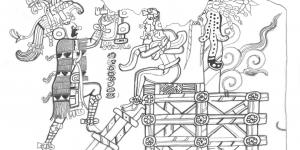You are here
How Was Abinadi a Prophet “Like unto Moses”?

Mosiah 13:5
The Know
In the Book of Mosiah, a prophet named Abinadi preached to the people of Zeniff, saying, “Thus saith the Lord—Wo be unto this people, for I have seen their abominations, and their wickedness, and their whoredoms; and except they repent I will visit them in mine anger” (Mosiah 11:20). Because the book of Deuteronomy used the prophetic gifts of Moses as a high standard against which future prophets would be measured, it is significant that throughout Mosiah 11–17, “the story of Abinadi is framed with elements of the story of Moses and his confrontation with Pharaoh.”1
As explained by David R. Seely, viewing Abinadi in this light would have only further amplified the power of Abinadi’s teachings in the minds of all biblically knowledgeable people. Indeed, the account of Moses’s life was “monumental and served as beacons to those in the future, pointing all who emulated [Moses] toward Christ.”2 It should be no surprise, then, that Christ stands at the center of Abinadi’s message to Noah and his priests, for which testimony Abinadi would ultimately lay down his life.
Comparisons between Moses and Abinadi can immediately be seen in the introduction of King Noah in Mosiah 11. According to the book of Mosiah, Noah “put down all the priests that had been consecrated by his father, and consecrated new ones in their stead, such as were lifted up in the pride of their hearts” (Mosiah 11:5). Furthermore, “Noah has put his people in bondage” through heavy taxation in order to benefit himself and his priests (see Mosiah 11:1–15).3 Similarly, pharaoh had “sorcerers” and “magicians of Egypt,” and Exodus 7:11 uses a Hebrew word that derives from the Egyptian hry-tp, a “title often borne by Egyptian priests.”4 Like Noah, the pharaoh also made the children of Israel live in “hard bondage” and construct many buildings for him (Exodus 1:14).
Furthermore, when Noah heard Abinadi’s message, he initially responded, “Who is Abinadi, that I and my people should be judged of him, or who is the Lord, that shall bring upon my people such great affliction?” (Mosiah 11:27). This challenge precisely echoes “the words first spoken by Pharaoh to Moses and Aaron,” who asked, “Who is the Lord, that I should obey his voice to let Israel go?” (Exodus 5:2).5 Throughout both kings encounters with the prophets, each was also said to harden their hearts despite repeated prophetic warnings (see Mosiah 11:29; Joseph Smith Translation, Exodus 7:13).
In contrast, both Moses and Abinadi had initially served the people but had to flee out of the land for their lives. Abinadi returned “after the space of two years,” just as Moses returned to Egypt after many years. Because neither of the kings addressed by these two prophets was willing to hear God’s message, both prophets delivered a far more dire message that included plagues because of the king’s unrepentant heart. As Seely observes, Abinadi “enumerated a list of signs that would occur if the people did not repent, signs reminiscent of the plagues of Moses: afflictions, famine, pestilence, bondage, hail, the east wind, insects (see Mosiah 12:3–7; Exodus 7–10), and even the death of Noah, whose life ‘[should] be valued even as a garment in a hot furnace’ (Mosiah 12:3).”6 Furthermore, through these plagues, Noah and the pharaoh would each know “know that I am the Lord” (Mosiah 12:3; Exodus 7:5).
Additionally, both Abinadi and Moses issued direct challenges to the wicked high priests—in Abinadi’s case, this challenge came through a series of questions and answers that demonstrated the wicked priests’ hypocrisy regarding what they taught the people and how they lived (see Mosiah 12:25–29). For Moses, this contest involved miraculous acts the magicians attempted to emulate, but their powers were ultimately inferior to the Lord’s (see, for example, Exodus 7:8–12). In both cases, it was clear who the true prophet of the Lord was because they could utilize His power.
Mormon also directly compares Abinadi to Moses in the text, further cementing these comparisons. After Abinadi recited the Ten Commandments to Noah and his priests—an act that would have directly cast him as a prophet like Moses by itself—Abinadi states that the children of Israel who were led out of Egypt “were a stiffnecked people, quick to do iniquity, and slow to remember the Lord their God,” not unlike his current audience (Mosiah 13:29).7 And, after reciting the first two commandments, Mormon records that “the Spirit of the Lord was upon [Abinadi]; and his face shone with exceeding luster, even as Moses’ did while in the mount of Sinai, while speaking with the Lord” (Mosiah 13:5).
Unfortunately, Noah and all his priests (except for Alma) rejected Abinadi’s message. Abinadi had already told Noah, however, “What you do with me, after this, shall be as a type and a shadow of things which are to come” (Mosiah 13:10). Because Noah ordered Abinadi to be “scourged … with faggots, yea, even unto death,” Abinadi prophesied that Noah and the unrepentant priests would “be hunted, and ye shall be taken by the hand of your enemies, and then ye shall suffer, as I suffer, the pains of death by fire” (Mosiah 17:13, 18).8 This ironic twist of fate for the king likewise is comparable to the ironic twist of fate that the pharaoh experienced in Exodus. Seely observed, “In the Exodus story, Pharaoh and his armies, ironically, suffered death in the waters of the Red Sea (see Exodus 14)—the same death that Pharaoh had decreed upon the Hebrew male children—to be cast into the water.”9 Further similarities can be seen in the table below.
Table 1. Similarities between the stories of Abinadi and Moses
|
Similarity |
Scripture |
|
A wicked king installs wicked priests |
Mosiah 11:5; Exodus 1:8; 7:11 |
|
A wicked king subjects the people |
Mosiah 11:1–15; Exodus 1:13–14 |
|
A wicked king rejects the Lord’s authority |
Mosiah 11:27; Exodus 5:2 |
|
A wicked king hardens his heart |
Mosiah 11:29; Joseph Smith Translation, Exodus 7:13 |
|
The prophet initially flees for his life |
Mosiah 11:26; 12:1; Exodus 2:15 |
|
The prophet delivers a series of plagues |
Mosiah 12:3–7; Exodus 7–10 |
|
The wicked king will eventually acknowledge the Lord |
Mosiah 12:3; Exodus 7:5, 17 |
|
The prophet challenges the wicked priests |
Mosiah 12:25–29; Exodus 7:8–12 |
|
The prophet is transfigured |
Mosiah 13:5; Exodus 34:29–30 |
|
The prophet delivers the law |
Mosiah 12:34–36; 13:12–24; Exodus 20:1–17 |
|
The prophet speaks to a stiff-necked people |
Mosiah 13:29; Exodus 32:9 |
|
The wicked king’s death reflects what he had inflicted on God’s people |
Mosiah 17:15–18; Exodus 1:22; 14:26–31 |
The Why
As prophets of the Lord, both Abinadi and Moses took seriously their responsibility to teach the people about Jesus Christ. This responsibility was made clear when Abinadi asked Noah and his priests, “Did not Moses prophesy unto them concerning the coming of the Messiah, and that God should redeem his people? Yea, and even all the prophets who have prophesied ever since the world began—have they not spoken more or less concerning these things?” (Mosiah 13:33). It is no surprise, then, that Abinadi would likewise offer a memorable sermon regarding Jesus Christ, His redemption, and His Atonement, which he did drawing on Isaiah 52:7–10 and Isaiah 53.10
Abinadi also pointed forward to Jesus Christ through his life as well, especially in light of Isaiah’s prophecies of the Savior. Like Christ, Abinadi would be mocked, rejected, and ultimately killed for declaring the good news of Christ’s Atonement. However, Abinadi’s ministry was not in vain, and the priest Alma “believed the words which Abinadi had spoken,” going on to convert others and start a church in the wilderness (Mosiah 17:2). John Hilton III summarized,
Abinadi’s influence on the text of the Book of Mormon may be underestimated by some. As a pivotal prophet who spoke 450 years after Lehi left Jerusalem, he is responsible for the conversion of Alma. Alma and his posterity would keep the sacred records and guide the Church for the next 470 years. Abinadi, living chronologically halfway between Lehi and Mormon, thus radically shaped the second half of Nephite history. … Abinadi’s testimony of Christ affected generations and clearly had an important textual influence on later Book of Mormon individuals.11
In short, through Alma’s ministry, countless others would come to know of the Lord’s goodness and mercy, shaping generations of righteous Nephites. Ultimately, through Abinadi’s unwavering faith and dedication to the Lord, Abinadi was able to work in many ways in his capacity as a prophet “like unto Moses,” pointing countless souls to Jesus Christ, both anciently and in modern times.
Further Reading
David Rolph Seely, “Abinadi, Moses, Isaiah, and Christ: ‘O How Beautiful upon the Mountains Are Their Feet,’” in The Book of Mormon: The Foundation of Faith, ed. Joseph Fielding McConkie, David M. Whitchurch, Fred E. Woods, and Patty A. Smith (Salt Lake City, UT: Deseret Book, 1999), 201–216.
John W. Welch, Gordon C. Thomasson, and Robert F. Smith, “Abinadi and Pentecost,” in Reexploring the Book of Mormon, ed. John W. Welch (Provo, UT: Foundation for Ancient Research and Mormon Studies [FARMS]; Salt Lake City, UT: Deseret Book, 1992), 135–138.
John W. Welch and Greg Welch, “Did Abinadi Prophesy against King Noah on Pentecost?” in Charting the Book of Mormon: Visual Aids for Personal Study and Teaching (Provo, UT: FARMS, 1999), chart 9-124.
- 1. David Rolph Seely, “Abinadi, Moses, Isaiah, and Christ: ‘O How Beautiful upon the Mountains Are Their Feet,’” in The Book of Mormon: The Foundation of Faith, ed. Joseph Fielding McConkie, David M. Whitchurch, Fred E. Woods, and Patty A. Smith (Salt Lake City, UT: Deseret Book, 1999), 202. See Deuteronomy 18:15, 18; 34:10.
- 2. Seely, “Abinadi, Moses, Isaiah, and Christ,” 202.
- 3. Seely, “Abinadi, Moses, Isaiah, and Christ,” 202.
- 4. William H. C. Propp, Exodus 1–18: A New Translation with Introduction and Commentary (New York, NY: Doubleday, 1999), 322. This term translates to “he that is at the head, chief” and may reflect the high priests mentioned in Mosiah 11:11.
- 5. Seely, “Abinadi, Moses, Isaiah, and Christ,” 203.
- 6. Seely, “Abinadi, Moses, Isaiah, and Christ,” 203. For a discussion on the plagues of Egypt specifically, see Book of Mormon Central, “Why Were Particular Plagues Sent against Egypt? (Exodus 7:3, 5),” KnoWhy 631 (March 31, 2022). On these plagues in the Book of Mormon’s potential New World setting, see Book of Mormon Central, “Why Did Abinadi Warn the People of an East Wind? (Mosiah 12:6–7),” KnoWhy 560 (May 5, 2020).
- 7. It is also possible that Abinadi spoke to Noah at Pentecost, which celebrated Moses receiving this law on Mount Sinai. This timing would only strengthen the comparison of Abinadi to Moses. See Book of Mormon Central, “Did Abinadi Prophesy during Pentecost? (Mosiah 13:5),” KnoWhy 90 (May 2, 2016); John W. Welch, Gordon C. Thomasson, and Robert F. Smith, “Abinadi and Pentecost,” in Reexploring the Book of Mormon, ed. John W. Welch (Provo, UT: Foundation for Ancient Research and Mormon Studies [FARMS]; Salt Lake City, UT: Deseret Book, 1992), 135–138; John W. Welch and Greg Welch, “Did Abinadi Prophesy against King Noah on Pentecost?” in Charting the Book of Mormon: Visual Aids for Personal Study and Teaching (Provo, UT: FARMS, 1999), chart 9-124; John W. Welch, John W. Welch Notes (Springville, UT: Book of Mormon Central, 2020), 461–462.
- 8. For a discussion on this method of execution in the New World (that is, being whipped with flaming torches) see Book of Mormon Central, “Why Was Abinadi Scourged with Faggots? (Mosiah 17:13),” KnoWhy 96 (May 10, 2016); Mark Alan Wright and Kerry Hull, “Ethnohistorical Sources and the Death of Abinadi,” in Abinadi: He Came among Them in Disguise, ed. Shon D. Hopkin (Provo, UT: Religious Studies Center, Brigham Young University; Salt Lake City: Deseret Book, 2018), 209–230.
- 9. Seely, “Abinadi, Moses, Isaiah, and Christ,” 213. Additional comparisons can be made between the subsequent chapters of Mosiah and the Exodus narrative as well. See Book of Mormon Central, “Why Does the Book of Mosiah Refer to the Exodus Narrative? (Mosiah 11:27),” KnoWhy 516 (May 16, 2019).
- 10. See Mosiah 12:20–33, 15:14–20, and 13:31–15:13 for each section of Isaiah, respectively.
- 11. John L. Hilton III, “Abinadi’s Legacy: Tracing His Influence through the Book of Mormon,” in Abinadi, 109.
KnoWhy Citation
Related KnoWhys
Subscribe
Get the latest updates on Book of Mormon topics and research for free





